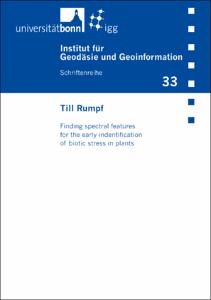Rumpf, Till: Finding spectral features for the early indentification of biotic stress in plants. - Bonn, 2013. - , . In: Schriftenreihe / Institut für Geodäsie und Geoinformation, 33.
Online-Ausgabe in bonndoc: https://hdl.handle.net/20.500.11811/1431
Online-Ausgabe in bonndoc: https://hdl.handle.net/20.500.11811/1431
@phdthesis{handle:20.500.11811/1431,
author = {{Till Rumpf}},
title = {Finding spectral features for the early indentification of biotic stress in plants},
school = {},
year = 2013,
series = {Schriftenreihe / Institut für Geodäsie und Geoinformation},
volume = 33,
note = {Early detection of biotic stress in plants is vital for precision crop protection, but hard to achieve. Prediction of plant diseases or weeds at an early stage has significant influence on the extent and effectiveness of crop protection measures. The precise measure depends on specific weeds and plant diseases and their economic thresholds. Weeds and plant diseases at an early stage, however, are difficult to identify. Non-invasive optical sensors with high resolution are promising for early detection of biotic stress. The data of these sensors, e.g. hyperspectral or fluorescence signatures, contain relevant information about the occurrence of pathogens.
Shape parameters, derived from bispectral images, have enormous potential for an early identification of weeds in crops. The analysis of this high dimensional data for an identification of weeds and pathogens as early as possible is demanding as the sensor signal is affected by many influencing factors. Nevertheless, advanced methods of machine learning facilitate the interpretation of these signals. Whereas traditional statistics estimate the posterior probability of the class by probability distribution, machine learning methods provide algorithms for optimising prediction accuracy by the discriminant function. Machine learning methods with robust training algorithms play a key role in handling non-linear classification problems.
This thesis presents an approach which integrates modern sensor techniques and advanced machine learning methods for an early detection and differentiation of plant diseases and weeds. Support vector machines (SVMs) equipped with non-linear kernels prove as effective and robust classifiers. Furthermore, it is shown that even a presymptomatic identification based on the combination of spectral vegetation indices is realised. Using well-established data analysis methods of this scientific field, this has not achieved so far.
Identifying disease specific features from the underlying original high dimensional sensor data selection is conducted. The high dimensionality of data affords a careful selection of relevant and non-redundant features depending on classification problem and feature properties. In the case of fluorescence signatures an extraction of new features is necessary. In this context modelling of signal noise by an analytical description of the spectral signature improves the accuracy of classification substantially. In the case of weed discrimination accuracy is improved by exploiting the hierarchy of weed species.
This thesis outlines the potential of SVMs, feature construction and feature selection for precision crop protection. A problem-specific extraction and selection of relevant features, in combination with task-oriented classification methods, is essential for robust identification of pathogens and weeds as early as possible.},
url = {https://hdl.handle.net/20.500.11811/1431}
}
author = {{Till Rumpf}},
title = {Finding spectral features for the early indentification of biotic stress in plants},
school = {},
year = 2013,
series = {Schriftenreihe / Institut für Geodäsie und Geoinformation},
volume = 33,
note = {Early detection of biotic stress in plants is vital for precision crop protection, but hard to achieve. Prediction of plant diseases or weeds at an early stage has significant influence on the extent and effectiveness of crop protection measures. The precise measure depends on specific weeds and plant diseases and their economic thresholds. Weeds and plant diseases at an early stage, however, are difficult to identify. Non-invasive optical sensors with high resolution are promising for early detection of biotic stress. The data of these sensors, e.g. hyperspectral or fluorescence signatures, contain relevant information about the occurrence of pathogens.
Shape parameters, derived from bispectral images, have enormous potential for an early identification of weeds in crops. The analysis of this high dimensional data for an identification of weeds and pathogens as early as possible is demanding as the sensor signal is affected by many influencing factors. Nevertheless, advanced methods of machine learning facilitate the interpretation of these signals. Whereas traditional statistics estimate the posterior probability of the class by probability distribution, machine learning methods provide algorithms for optimising prediction accuracy by the discriminant function. Machine learning methods with robust training algorithms play a key role in handling non-linear classification problems.
This thesis presents an approach which integrates modern sensor techniques and advanced machine learning methods for an early detection and differentiation of plant diseases and weeds. Support vector machines (SVMs) equipped with non-linear kernels prove as effective and robust classifiers. Furthermore, it is shown that even a presymptomatic identification based on the combination of spectral vegetation indices is realised. Using well-established data analysis methods of this scientific field, this has not achieved so far.
Identifying disease specific features from the underlying original high dimensional sensor data selection is conducted. The high dimensionality of data affords a careful selection of relevant and non-redundant features depending on classification problem and feature properties. In the case of fluorescence signatures an extraction of new features is necessary. In this context modelling of signal noise by an analytical description of the spectral signature improves the accuracy of classification substantially. In the case of weed discrimination accuracy is improved by exploiting the hierarchy of weed species.
This thesis outlines the potential of SVMs, feature construction and feature selection for precision crop protection. A problem-specific extraction and selection of relevant features, in combination with task-oriented classification methods, is essential for robust identification of pathogens and weeds as early as possible.},
url = {https://hdl.handle.net/20.500.11811/1431}
}






